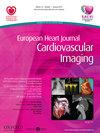Semi-automatic quantification of aortic root progressive dilation by automatic co-registration of computed tomography angiograms: a preliminary comparison with manual assessment in Marfan patients
引用次数: 0
Abstract
Type of funding sources: Public Institution(s). Main funding source(s): Spanish Ministry of Science, Innovation and Universities Instituto de Salud Carlos III Background. Dilation of the aortic root is a key feature of Marfan syndrome and it is related to the occurrence of aortic events and death. On top of maximum diameter, rapid annual growth rate is suggested by guidelines for indication of aortic root replacement. Current gold-standard for aortic root diameter assessment is manual quantification on multiplanar reformatted 3D computed tomography (CT) or magnetic resonance angiogram. However, inter- and intra-observer reproducibility are limited and different measurement methods, i.e. cusp-to-cusp and cusp-to-commissure, may be used in different clinical centres, leading to difficulties in the clinical assessment of progressive dilation. Purpose. We aimed to test whether aortic root growth rate during follow-up can be reliably quantified by semi-automatic co-registration of two CT angiograms. Methods. Seven Marfan syndrome patients, free from previous aortic surgery, with a total of 11 pairs of CT were identified. Manual assessment of six aortic root diameters (right-non coronary -RN- , right-left -RL- and left-non coronary -LN- cusp-to-cusp and R, L and N cusp-to-commissure) was obtained from all CTs by an experienced researcher blind to semi-automatic results. The thoracic aorta and the outflow tract were semi-automatically segmented in the baseline CT and commissure and cusps were manually located. A 10 mm-thick region of interest containing the aortic wall was automatically generated from segmentation boundary. Co-registration was obtained with three, fully-automatic steps. Firstly, baseline and follow-up CT scans were aligned by means of a rigid registration. Then, scans were co-registered with multi-resolution affine followed by b-spline non-rigid registrations based on mutual information metric. The transformation pertaining to the location of baseline commissure and cusps points was used to locate the same points in the follow-up scan (Fig. 1 top). Results. Follow-up duration was 35 ± 22 (range 12-70.3) months. Automatic quantification of diameter growth during the follow-up was obtained in 62 out of 66 (94%) diameter comparisons. High Pearson correlation coefficients (R) and ICC were found between manual and semi-automatic assessment of growth rate, both for cusp-to-cusp and cusp-to-commissure diameters: R = 0.727 and ICC = 0.678 for RN; R = 0.822 and ICC = 0.602 for RL; R = 0.648 and ICC = 0.668 for LN; R = 0.726 and ICC = 0.711 for R; R = 0.911 and ICC = 0.895 for L and R = 0.553 and ICC = 0.482 for N. Scatter and Bland-Altman plots for all growth rates (Fig. 1) confirmed very good correlation (R = 0.810) but a slight tendency (R=-0.270) for underestimation at high growth rate. No correlation was found between follow-up duration and difference between techniques (R = 0.06). Conclusions. Semi-automatic quantification of aortic root growth rate by co-registration of pairs of CT angiograms is feasible for follow-up as short as one year. Larger studies are needed to confirm these preliminary data. Abstract Figure. CT measurements. Automatic vs manual.通过计算机断层扫描血管造影自动配准半自动量化主动脉根部进行性扩张:与马凡氏病患者人工评估的初步比较
资金来源类型:公共机构。主要资助来源:西班牙科学、创新和大学部Salud Carlos III研究所。主动脉根部扩张是马凡氏综合征的一个重要特征,它与主动脉事件的发生和死亡有关。主动脉根置换术的指征是在最大直径的基础上,快速的年增长率。目前评估主动脉根部直径的金标准是在多平面重新格式化的三维计算机断层扫描(CT)或磁共振血管造影上进行人工量化。然而,观察者之间和观察者内部的可重复性是有限的,不同的测量方法,即尖端到尖端和尖端到连接,可能在不同的临床中心使用,导致临床评估进行性扩张的困难。目的。我们的目的是测试随访期间主动脉根部生长速度是否可以通过两张CT血管造影的半自动联合登记来可靠地量化。方法。7例马凡氏综合征患者,既往无主动脉手术史,共11对CT。人工评估6个主动脉根直径(右-非冠状动脉- rn -,右-左- rl -和左-非冠状动脉- ln -尖对尖和R, L和N尖对连接)由经验丰富的研究人员从所有ct中获得半自动结果。在基线CT上半自动分割胸主动脉和流出道,手动定位连接点和尖点。根据分割边界自动生成包含主动脉壁的10mm厚感兴趣区域。共登记通过三个全自动步骤获得。首先,基线和随访CT扫描通过刚性配准的方式对齐。然后,对扫描进行多分辨率仿射配准,然后进行基于互信息度量的b样条非刚性配准。在后续扫描中,使用与基线接合点和尖端点位置相关的变换来定位相同的点(图1顶部)。结果。随访时间为35±22(12-70.3)个月。66例(94%)直径比较中有62例在随访期间获得了直径增长的自动量化。人工和半自动评估生长速率之间的Pearson相关系数(R)和ICC都很高,无论是对于尖端到尖端的直径还是尖端到连接的直径:RN的R = 0.727, ICC = 0.678;RL的R = 0.822, ICC = 0.602;LN的R = 0.648, ICC = 0.668;R = 0.726, ICC = 0.711;L的R= 0.911和ICC = 0.895, n的R= 0.553和ICC = 0.482,所有增长率的散点图和Bland-Altman图(图1)证实了非常好的相关性(R= 0.810),但在高增长率下有轻微的低估趋势(R=-0.270)。随访时间与技术差异无相关性(R = 0.06)。结论。在短至一年的随访中,通过对CT血管造影的联合登记半自动量化主动脉根部生长速率是可行的。需要更大规模的研究来证实这些初步数据。抽象的图。CT测量。自动vs手动。
本文章由计算机程序翻译,如有差异,请以英文原文为准。
求助全文
约1分钟内获得全文
求助全文

 求助内容:
求助内容: 应助结果提醒方式:
应助结果提醒方式:


